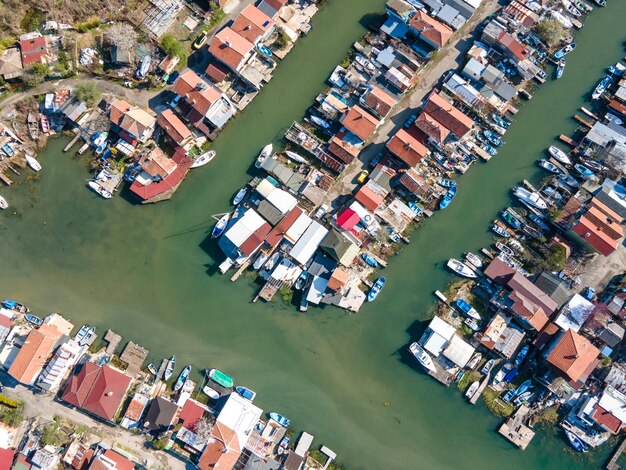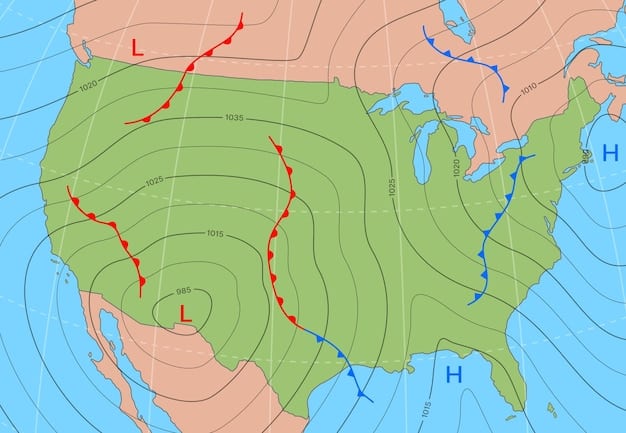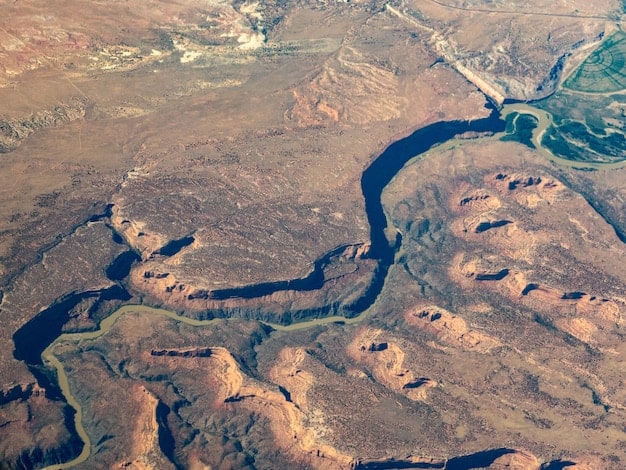US Climate Displacement: Projections by 2030

The projected increase in climate-related displacement within the US by 2030 is subject to various factors including the severity of climate change impacts and the effectiveness of adaptation strategies, with estimates from institutions like the World Bank and various academic studies suggesting millions could be internally displaced.
As the planet continues to warm, the discussion around climate change impacts intensifies, bringing into sharp focus the concept of climate-related displacement. For the United States, a nation of diverse geographies and communities, understanding what is the projected increase in climate-related displacement of people within the US by 2030? becomes paramount. This isn’t merely an academic exercise; it’s about anticipating future challenges and developing resilient strategies to protect our communities and infrastructure.
Understanding Climate-Related Displacement: A Growing Concern
Climate-related displacement refers to the forced movement of people from their homes or livelihoods due to sudden or slow-onset climate change impacts. These impacts can range from extreme weather events like hurricanes, floods, and wildfires to gradual environmental degradation such as sea-level rise, desertification, and prolonged droughts. In the United States, the vulnerability to these events varies significantly across regions, making the issue complex and multifaceted.
The concept extends beyond immediate disaster response, encompassing the long-term societal and economic consequences that force people to seek new, safer locations. It highlights the intersection of environmental science, social justice, and urban planning. Addressing this challenge requires not only mitigation efforts to reduce greenhouse gas emissions but also proactive adaptation strategies to prepare communities for inevitable changes.
Historical Context and Current Trends
While the term “climate-related displacement” has gained prominence recently, the US has a history of populations moving due to environmental factors. The Dust Bowl era of the 1930s saw large-scale migration from the Great Plains due to severe drought and poor land management practices. More recently, events like Hurricane Katrina in 2005, which displaced over a million people, and the ongoing wildfires in California, exemplify the direct and devastating link between extreme weather and population movement.
Current trends indicate an accelerating pace of climate impacts. Coastal communities face increasing threats from sea-level rise and more intense storm surges. The Southwest grapples with persistent drought and water scarcity, while inland areas experience more frequent and severe heatwaves and flooding. These trends are not isolated; they often interact, amplifying risks and creating complex displacement patterns.
- Coastal Erosion and Sea-Level Rise: Threatens homes and infrastructure along the Atlantic, Gulf, and Pacific coasts.
- Increased Frequency of Extreme Weather: More intense hurricanes, floods, and wildfires necessitate temporary and sometimes permanent relocation.
- Water Scarcity and Drought: Impacts agriculture and livability in arid and semi-arid regions.
- Heatwaves: Render certain areas uninhabitable or severely impact public health, particularly for vulnerable populations.
These incidents underscore the need for a comprehensive understanding of how climate change is already shaping human mobility. The challenge lies in distinguishing climate-induced displacement from other factors influencing migration, such as economic opportunities or social pressures, which often intertwine.
The scale of future displacement will depend on a combination of factors, including the rate of global warming, the effectiveness of national and local adaptation measures, and the socio-economic resilience of affected communities. Early and proactive planning can significantly reduce the disruptive impacts of climate-related displacement, turning potential crises into manageable transitions.
Projected Scenarios and Methodologies by 2030
Forecasting human displacement is inherently complex, as it involves intertwining environmental, social, economic, and political factors. However, various organizations and researchers employ sophisticated models and methodologies to project potential scenarios for climate-related displacement within the US by 2030. These projections serve as critical tools for policymakers and urban planners.
The foundation of these projections often rests on analyzing climate models that anticipate changes in sea levels, precipitation patterns, temperature extremes, and the frequency of severe weather events. This atmospheric and oceanic data is then layered with demographic information, social vulnerabilities, economic indicators, and infrastructure locations to identify areas most at risk and populations most likely to be displaced.
Key Research and Reports Shaping Projections
Several institutions have contributed significantly to our understanding of future displacement. The World Bank, in its “Groundswell” report series, has provided global and regional estimates of internal climate migrants. While precise US-specific figures for 2030 are often embedded within broader North American or high-income country analyses, their methodologies highlight the key drivers of displacement applicable to the US context: water stress, decreasing crop productivity, and sea-level rise.
Domestically, institutions like the Union of Concerned Scientists, the Environmental Protection Agency (EPA), and various university research centers (e.g., Columbia University’s Earth Institute, University of Notre Dame’s Environmental Change Initiative) have published detailed reports focusing on US vulnerabilities. These reports often use geospatial analysis to map out areas prone to specific climate hazards and project the number of people residing in those zones who might be compelled to move.
For instance, some studies focus on coastal populations vulnerable to sea-level rise, estimating millions residing in low-lying areas. Others examine the potential for “climate migrants” from the arid Southwest seeking refuge in more water-secure regions or from flood-prone areas moving to higher ground. The challenge is not just the number of people, but where they might go and the implications for both origin and destination communities.
Modeling Challenges and Assumptions
Despite advancements, projections come with inherent uncertainties and depend on crucial assumptions. One major variable is the future trajectory of global greenhouse gas emissions. Different emissions pathways (e.g., high-emission “business as usual” versus aggressive mitigation scenarios) lead to vastly different climate outcomes, and consequently, different displacement figures.
Another significant factor is the level of societal adaptation. Robust investments in infrastructure (e.g., seawalls, resilient housing), early warning systems, and community-based relocation programs can significantly mitigate displacement impacts. Conversely, a lack of proactive measures could exacerbate the problem. Projections often assume a certain level of adaptation, making these assumptions critical to the outcomes.
- Emissions Scenarios: Different IPCC (Intergovernmental Panel on Climate Change) scenarios directly influence projected climate impacts.
- Adaptation Measures: The extent of investment in resilience and relocation directly affects displacement numbers.
- Socio-economic Factors: Economic disparities, housing markets, and community cohesion play a role in who can move and where.
- Policy Responses: Government policies on zoning, disaster relief, and federal assistance influence long-term migration patterns.
These models also grapple with the “tipping points” – thresholds beyond which climate impacts become irreversible or trigger mass movements. Predicting these precisely by 2030 is difficult, making projections dynamic and subject to revision as new data and understanding emerge.
Ultimately, while no single definitive number can be cited with absolute certainty for 2030, the scientific consensus points towards a future where climate change will significantly alter population distribution within the US. The magnitude of this shift will largely depend on the collective actions taken in the coming years.

Key Drivers of Internal Climate Migration in the US
The phenomenon of climate-related displacement within the US is not uniformly distributed. Instead, it is driven by specific climate hazards that disproportionately affect certain regions and populations. Understanding these key drivers is essential for conceptualizing the scale and nature of internal migration movements by 2030.
These drivers often intersect and compound each other, creating cascading impacts. For example, a coastal community might face both sea-level rise and increased hurricane intensity, leading to property damage, economic disruption, and eventual relocation pressure. Furthermore, existing socio-economic vulnerabilities can amplify the impact of these environmental stressors, leading to differential displacement outcomes for various demographic groups.
Coastal Inundation and Sea-Level Rise
One of the most widely cited drivers of future displacement is coastal inundation due to rising sea levels. The National Oceanic and Atmospheric Administration (NOAA) projects significant increases in sea levels along US coastlines by 2030 and beyond. This rise, coupled with more frequent and intense storm surges, threatens to permanently or repeatedly flood low-lying coastal communities.
States like Florida, Louisiana, and many along the Mid-Atlantic and Pacific Northwest coasts are particularly vulnerable. As saltwater intrusion contaminates freshwater sources and infrastructure becomes increasingly difficult to maintain in perpetually wet conditions, residents may have no choice but to move inland. The scale of this movement depends on the rate of sea-level rise, but even conservative estimates suggest hundreds of thousands, if not millions, could be affected by mid-century, with initial shifts occurring by 2030.
Extreme Heat and Water Scarcity in the Southwest
Beyond coastal threats, the American Southwest faces acute challenges from extreme heat and chronic water scarcity. Prolonged droughts, exacerbated by rising temperatures, deplete reservoirs and groundwater supplies, impacting agriculture, industry, and daily life. Cities like Phoenix, Las Vegas, and others in the desert Southwest are already grappling with managing water resources under increasing strain.
- Agricultural Viability: Reduced water availability impacts crop yields, threatening livelihoods and food security.
- Human Health: Extreme heat poses severe health risks, particularly for outdoor workers and vulnerable populations.
- Increased Wildfire Risk: Dry conditions fuel larger and more frequent wildfires, forcing evacuations and long-term displacement.
- Infrastructure Strain: Power grids and water delivery systems become stressed under high demand and extreme conditions.
While direct “mass migration” solely due to heat by 2030 might be limited, the cumulative effects of heat, water stress, and associated declines in economic opportunities could prompt smaller, but significant, relocation trends towards cooler or wetter regions. This slow-onset displacement is harder to track but no less impactful.
The combination of these factors paints a picture of a dynamic internal landscape where populations ebb and flow in response to environmental pressures. Understanding these specific drivers allows for targeted resilience-building and policy interventions.
Socio-Economic Factors Influencing Displacement
While climate hazards provide the impetus for displacement, socio-economic factors often determine who moves, when, and where. These elements act as amplifiers or mitigators, shaping the vulnerability and resilience of communities in the face of environmental change. By 2030, these underlying societal structures will continue to play a critical role in how climate-related displacement unfolds across the US.
Displacement is rarely a simple equation of hazard exposure; it is deeply embedded in issues of equity, access to resources, and historical injustices. Understanding these nuances is crucial for developing fair and effective relocation and adaptation policies.
Income Disparity and Access to Resources
Lower-income communities and minority populations are disproportionately affected by climate change impacts and have fewer resources to adapt or relocate. These communities often reside in areas more vulnerable to hazards (e.g., floodplains, contaminated industrial zones) due to historical discriminatory housing policies and limited housing options. When disaster strikes, they lack the financial means for home repairs, temporary housing, or long-term relocation.
This dynamic creates a cycle of vulnerability where repeated displacements can lead to chronic instability. Individuals with limited savings, insurance, or social networks find it extremely difficult to rebuild their lives elsewhere. By 2030, without targeted interventions, these disparities could widen, leading to “trapped populations” unable to move from increasingly hazardous areas, or forced migration into less desirable, often equally vulnerable, urban fringes.
Infrastructure and Urban Planning
The quality of existing infrastructure and the foresight in urban planning significantly influence a community’s resilience to climate impacts. Communities with robust flood defenses, modern storm drainage systems, and resilient power grids are better equipped to withstand extreme weather events, reducing the immediate need for displacement. Conversely, areas with aging infrastructure are more susceptible to prolonged disruptions, hastening the pressures to move.
- Outdated Infrastructure: Increases vulnerability to floods, power outages, and water contamination.
- Zoning Laws: Can either discourage or inadvertently encourage development in high-risk areas.
- Relocation Policies: Lack of comprehensive and equitable policies for planned retreat or managed relocation.
- Access to Services: Availability of healthcare, schools, and jobs in potential destination areas is critical for successful resettlement.
Moreover, the planning (or lack thereof) for receiving climate migrants is critical. Unplanned influxes of people can strain resources in destination cities, leading to housing shortages, increased competition for jobs, and potential social tensions. Effective urban planning, therefore, needs to account for both the impacts of climate change on specific territories and the potential demographic shifts it will induce across broader regions.
By 2030, the interplay of these socio-economic factors will be a defining characteristic of climate-related displacement. Addressing these disparities through equitable policy-making and strategic investments can foster a more just and resilient future for all.
Regional Hotspots and Projections for 2030
While climate change is a national concern, its manifestations and the resulting displacement pressures are intensely regional. Certain areas of the US are projected to become “hotspots” for climate-related displacement by 2030, driving significant internal migration patterns. Identifying these regions is paramount for targeted adaptation planning and resource allocation.
These hotspots are typically characterized by a high degree of exposure to specific climate hazards combined with inherent socio-economic vulnerabilities. The anticipated movements are not necessarily mass exodus events but rather a gradual, sometimes episodic, shifts in population over time leading up to 2030.
Coastal States: Southeast and Mid-Atlantic
The Southeast and Mid-Atlantic coasts are frequently cited as primary regions for anticipated displacement due to sea-level rise and increasing hurricane intensity. States like Florida, Louisiana, and parts of North Carolina and Virginia face a double threat: gradual inundation from rising tides and sudden, catastrophic damage from more powerful storms. Cities like Miami, New Orleans, and Norfolk are particularly vulnerable.
By 2030, it is projected that increasing “sunny day flooding” and more frequent, severe storm surges will make many coastal properties uninsurable or uninhabitable. While large-scale government-led managed retreat efforts might still be limited, a significant number of individuals and families will likely choose to relocate privately due to economic hardship and diminished quality of life. This could amount to hundreds of thousands of people moving to slightly higher ground or inland urban centers.
Southwest Deserts and California Wildfire Zones
The Southwest, encompassing Arizona, Nevada, Utah, and parts of California, is another key hotspot, though driven by different climate impacts: extreme heat, drought, and water scarcity. The Colorado River Basin, a vital water source for millions, faces ongoing depletion, raising concerns about the long-term viability of current population levels in desert cities.

In California, the increasing frequency and intensity of wildfires are already leading to temporary and sometimes permanent displacement. Communities on the wildland-urban interface are particularly at risk. By 2030, continued drought conditions and hotter temperatures will likely exacerbate these fire risks, potentially displacing tens of thousands of residents annually and driving a gradual shift away from highly exposed areas.
- Florida and Louisiana: Significant displacement due to sea-level rise and storm surge.
- Southeastern Coast: Vulnerability to intensifying hurricanes and coastal erosion.
- Arizona and Nevada: Pressures from extreme heat and diminishing water resources.
- California: Displacement driven by wildfires and prolonged droughts.
It’s important to note that these regional movements will not necessarily follow clear, linear paths. Many individuals may seek to remain within their home states, moving to nearby areas that are perceived as safer. However, cross-state migration could also occur, leading to demographic shifts in regions historically less impacted by climate extremes, such as parts of the Pacific Northwest or the Great Lakes region, which might be seen as “climate havens.”
By 2030, the cumulative effect of these localized displacements across multiple hotspots will contribute to a noticeable, though perhaps not immediately overwhelming, change in population distribution across the US, requiring proactive planning from both sending and receiving communities.
Policy Responses and Adaptation Strategies
Anticipating the projected increase in climate-related displacement by 2030 necessitates robust and proactive policy responses and adaptation strategies. Without effective planning and implementation, the social and economic costs of displacement could be enormous. Governments at all levels, alongside communities and the private sector, have a crucial role to play in mitigating these impacts.
These strategies fall broadly into two categories: those that aim to prevent displacement by enhancing resilience in place, and those that facilitate planned and equitable relocation when staying becomes untenable. A balanced approach is essential.
Building Resilience in Place
Many policies focus on making communities more resilient to climate impacts, thereby reducing the immediate need for displacement. This includes investments in “grey” infrastructure like seawalls, levees, and improved drainage systems, particularly in coastal and flood-prone areas. However, there’s a growing recognition of the importance of “green” infrastructure, such as restoring wetlands and planting urban forests, which provide natural flood protection and heat mitigation.
Updated building codes to withstand extreme weather, improved early warning systems, and enhanced emergency preparedness plans are also critical. Furthermore, economic diversification in vulnerable regions can create more resilient local economies less dependent on climate-sensitive industries like agriculture or tourism. Community-based adaptation programs that empower local residents to participate in planning and implement localized solutions are also key to fostering long-term resilience.
- Infrastructure Investments: Seawalls, levees, improved drainage, and resilient power grids.
- Natural Solutions: Wetland restoration, dune reinforcement, urban tree planting.
- Building Codes: Updating regulations for flood and wind resistance.
- Early Warning Systems: Enhancing disaster prediction and communication protocols.
- Economic Diversification: Reducing reliance on climate-vulnerable industries.
These measures aim to keep people safely in their homes and communities for as long as possible, preventing what might otherwise be forced displacement. However, for some areas, the reality of climate change means that remaining in place will eventually become unsustainable.
Facilitating Managed Relocation and Resettlement
For communities facing unavoidable climate impacts, policies need to focus on managed retreat or planned relocation. This is a highly sensitive and complex undertaking, as it involves moving entire neighborhoods or towns and protecting their cultural heritage and social cohesion. It requires significant funding for property buyouts, land acquisition, and the development of new, safe communities.
Equitable resettlement policies are vital to ensure that vulnerable populations are not left behind or forced into worse conditions. This includes providing financial assistance, housing support, job training, and access to services in receiving communities. Some states and federal agencies are beginning to explore pilot programs for managed retreat, but scaling these up to meet projected needs by 2030 will be a immense challenge.
Beyond physical relocation, policies also need to address the psychological and social impacts of displacement, offering support services for mental health and community rebuilding. Proactive legal frameworks that clearly define the rights of climate migrants and the responsibilities of governments are also necessary. Ultimately, a layered approach combining resilience in place with strategic, well-planned relocation options will be critical for navigating future climate-induced population shifts.
Challenges and Opportunities Ahead for the US
The projected increase in climate-related displacement within the US by 2030 presents both formidable challenges and unique opportunities. Navigating this complex future requires foresight, innovation, and a collective commitment to building a more resilient and equitable nation. The decisions made in the coming years will profoundly shape the lives of millions and the very fabric of American society.
While the scale of displacement might not represent a sudden mass exodus by 2030, the cumulative effect of localized movements will undoubtedly stress existing infrastructure, social services, and housing markets in both sending and receiving communities. Anticipating and responding to these shifts proactively is key.
Interstate and Intrastate Migration Pressures
One of the primary challenges will be managing internal migration flows. Interstate migration of climate migrants could place significant strain on “climate haven” cities or regions that are perceived as safer. These destinations may face rapid population growth, leading to increased demand for housing, public services, and infrastructure, potentially driving up costs and exacerbating existing inequalities if not properly managed.
Conversely, the depopulation of climate-impacted areas could lead to economic decline, reduced tax bases, and decaying infrastructure in those locations. The uneven distribution of impacts and adaptive capacities across states and municipalities could further deepen existing regional divides. Planning for these complex demographic shifts across jurisdictional lines will require unprecedented levels of intergovernmental cooperation and resource sharing.
- Housing Shortages: Increased demand in receiving areas can inflate housing costs.
- Infrastructure Strain: Overburdened public transportation, water, and waste systems in growth areas.
- Social Integration: Challenges in integrating displaced populations into new communities.
- Economic Decline: Loss of tax revenue and infrastructure neglect in areas of out-migration.
- Funding Gaps: Insufficient federal and state funding for both adaptation and relocation efforts.
Moreover, the ethical considerations of planned retreat, particularly for communities with deep historical and cultural ties to their land, will pose significant moral and logistical dilemmas that need to be addressed thoughtfully and equitably.
Innovation and Economic Opportunities
Despite the challenges, the necessity of adapting to climate-related displacement also presents significant opportunities for innovation and economic growth. The demand for climate-resilient infrastructure, sustainable urban planning solutions, and new technologies to monitor and manage environmental risks will spur job creation and investment in a “green economy.”
From developing advanced flood mapping systems to designing resilient building materials, and from creating new water conservation technologies to fostering community-led relocation models, the climate crisis can become a catalyst for transformative change. Furthermore, investments in climate-smart agriculture and ecosystem restoration can enhance food security and create new economic avenues.
The imperative to address climate migration can also drive improvements in social equity, as policies are designed to prioritize the needs of vulnerable populations. By proactively addressing climate-related displacement, the US has the chance to demonstrate global leadership in building a just, adaptive, and sustainable society for the 21st century.
| Key Aspect | Brief Description |
|---|---|
| 🌊 Driving Forces | Sea-level rise, extreme heat, wildfires, and water scarcity are key drivers. |
| 🗺️ Regional Hotspots | Coastal Southeast, Mid-Atlantic, and the Southwest face highest displacement risks. |
| 👥 Socio-economic Impact | Disproportionate effects on vulnerable communities due to income and resource disparities. |
| 🛠️ Adaptation & Policy | Calls for resilience in place and managed relocation policies to mitigate impacts. |
Frequently Asked Questions About Climate Displacement
▼
Climate-related displacement refers to the forced movement of people from their homes or livelihoods due to environmental changes directly or indirectly caused by climate change. This includes sudden events like hurricanes and floods, as well as slow-onset changes like sea-level rise and prolonged droughts. It’s a growing issue impacting communities globally and within the US.
▼
There isn’t a single definitive projection for 2030. Estimates vary widely depending on the climate scenarios and models used, ranging from hundreds of thousands to a few million. Major reports from institutions like the World Bank and various academic studies indicate that significant internal movement due to climate impacts is highly probable by then.
▼
Coastal areas, particularly in the Southeast (e.g., Florida, Louisiana) and Mid-Atlantic, are highly vulnerable to sea-level rise and extreme storms. The Southwest also faces significant risks from extreme heat, drought, and water scarcity. Parts of California are increasingly impacted by wildfires, leading to potential displacement.
▼
Yes, robust policy interventions can significantly mitigate climate displacement. These include investing in resilient infrastructure, updating building codes, implementing effective early warning systems, and developing thoughtful managed relocation programs for areas that become uninhabitable. Proactive planning is crucial to reducing forced migration.
▼
Climate displacement disproportionately affects vulnerable and lower-income communities who lack resources for relocation. It can strain housing markets and public services in receiving areas, lead to economic decline in areas of out-migration, and exacerbate existing social inequalities. Addressing these factors requires equitable and comprehensive planning.
Conclusion
The question of what is the projected increase in climate-related displacement of people within the US by 2030? is not about pinpointing an exact number, but rather acknowledging an undeniable trend. Scientific projections, coupled with real-world observations, indicate that climate change will increasingly compel Americans to move. This internal migration will be driven primarily by coastal inundation, extreme heat, water scarcity, and wildfires, reshaping regional demographics and placing stress on both sending and receiving communities. While the challenges are immense, from managing complex migration flows to ensuring equitable resettlement, there are also opportunities for innovation in infrastructure, urban planning, and social policy. By proactively investing in resilience and developing comprehensive, just adaptation strategies, the US can better prepare for and respond to the inevitable shifts in population driven by a changing climate, striving for a future that is both sustainable and equitable.





